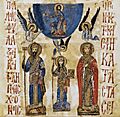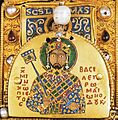Michael VII Doukas facts for kids
Quick facts for kids Michael VII Doukas |
|
|---|---|
| Emperor and Autocrat of the Romans | |

A cloisonné engraving of Michael VII Doukas in full imperial clothing, as seen in the Georgian Khakuli Triptych
|
|
| Byzantine emperor | |
| Reign | October 1071 – March 1078 |
| Coronation | c. 1060 as co-emperor |
| Predecessor | Romanos IV Diogenes |
| Successor | Nikephoros III Botaneiates |
| Regent | Eudokia Makrembolitissa (October–November 1071) |
| Co-emperors |
See list
|
| Born | c. 1050 |
| Died | 1090 (aged ~40) |
| Spouse | Maria of Alania |
| Issue | Constantine Doukas |
| Dynasty | Doukid |
| Father | Constantine X |
| Mother | Eudokia Makrembolitissa |
Michael VII Doukas was a Byzantine emperor who ruled from 1071 to 1078. He was also known by the nickname Parapinakes, which means "minus a quarter." This name came about because the value of the Byzantine money went down a lot during his time as emperor.
Michael VII was not seen as a strong leader. He often relied on his court officials, especially his finance minister, Nikephoritzes. During his rule, taxes went up, and money was spent on fancy things, but the army was not paid enough. This led to soldiers rebelling. The empire also lost an important city called Bari and faced a big revolt in the Balkans. The Seljuk Turks were also attacking from the east, and even some of Michael's own hired soldiers turned against the empire. In 1078, Michael decided to step down as emperor and later became a monk.
Contents
Early Life and Becoming Emperor

Michael VII was born around 1050 in Constantinople, which was the capital city of the Byzantine Empire. He was the oldest son of Emperor Constantine X Doukas and Empress Eudokia Makrembolitissa.
By the end of 1060, when he was about 10 years old, Michael was made a co-emperor with his father. When his father, Constantine X, died in 1067, Michael was 17. He was old enough to rule on his own, but he wasn't very interested in governing. So, his mother Eudokia and his uncle John Doukas acted as regents, meaning they ruled for him.
In 1068, his mother Eudokia married a general named Romanos IV Diogenes. Romanos then became the main co-emperor alongside Michael VII and his brothers.
Challenges and Losing Power
In August 1071, Romanos IV was defeated and captured by Alp Arslan, the leader of the Seljuk Turks, at the Battle of Manzikert. After this big defeat, Michael VII became the emperor on October 1, 1071. His mother Eudokia was sent to a monastery.
Michael VII was advised by his uncle John Doukas and his teacher Michael Psellos. However, he started to rely more and more on his finance minister, Nikephoritzes. Michael was more interested in studying than in ruling. This allowed Nikephoritzes to raise taxes and spend a lot on luxuries, while the army was not given enough money.
Because the army was underpaid, soldiers often rebelled. The Byzantines lost Bari, their last city in Italy, to the Normans in 1071. At the same time, there was a serious revolt in the Balkans led by Georgi Voyteh. Even though this revolt was stopped, the Byzantine Empire could not get back the lands it had lost in Asia Minor.
After the Battle of Manzikert, the Byzantine government sent a new army to fight the Seljuk Turks. But this army was also defeated in 1073. The situation got even worse when the Byzantine Empire's hired soldiers from the west, led by Roussel de Bailleul, left the army. They tried to create their own independent area. Michael's uncle, John Doukas, led an army against them, but he was also captured. Roussel then forced John Doukas to pretend he was the emperor and attacked a city near Constantinople. Finally, a new army led by Alexios I Komnenos (who would later become emperor) defeated Roussel and captured John Doukas in 1074.
These problems, along with the money losing its value, made many people unhappy. This is why Michael got his nickname Parapinakēs. In 1078, two generals, Nikephoros Bryennios and Nikephoros Botaneiates, started revolts. Botaneiates reached Constantinople first. Michael VII gave up his throne on March 24 or 31, 1078, without much of a fight. He then went to live in the Monastery of Stoudios. He later became a church leader in Ephesus and died around 1090 in Constantinople.
Family Life
Michael VII Doukas married Maria of Alania. She was the daughter of King Bagrat IV of Georgia. They had at least one son together, named Constantine Doukas. Constantine was a co-emperor with his father from about 1075 to 1078, and again from 1081 to 1087/8. He passed away around 1095.
Images for kids
-
Miniature of Michael VII alongside Constantine X and Eudokia, c. 1060
-
Michael VII and Maria of Alania on the Khakhuli triptych, c. 1072.
-
Michael VII Doukas on the back of the Holy Crown of Hungary, c. 1074.
-
Miniature of Michael VII, later changed to show Nikephoros III
See also
 In Spanish: Miguel VII Ducas para niños
In Spanish: Miguel VII Ducas para niños







